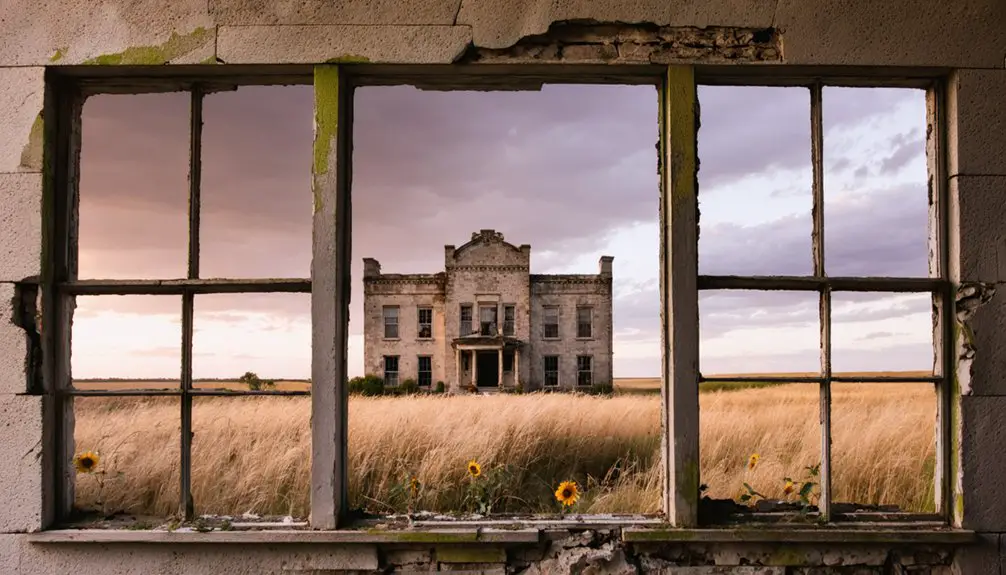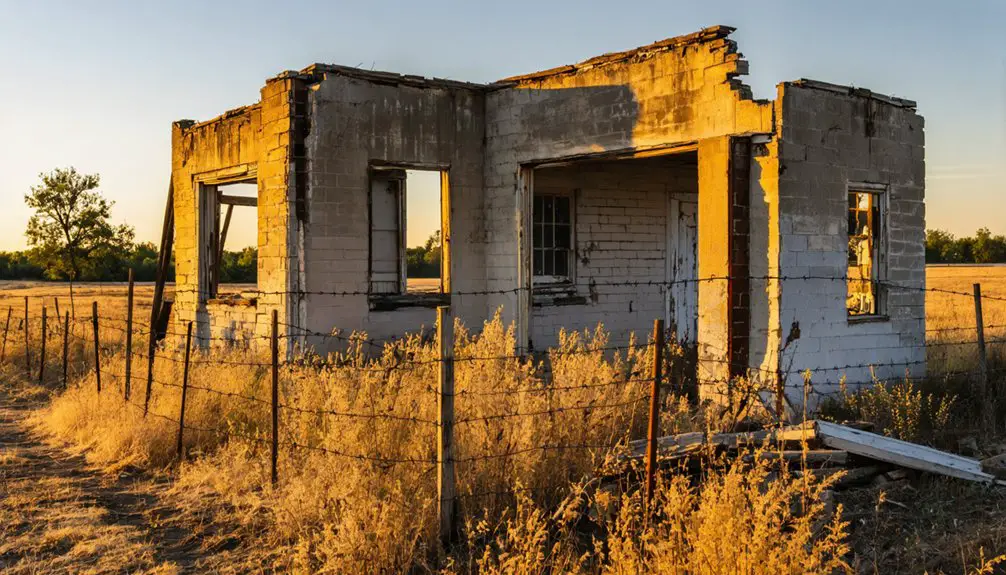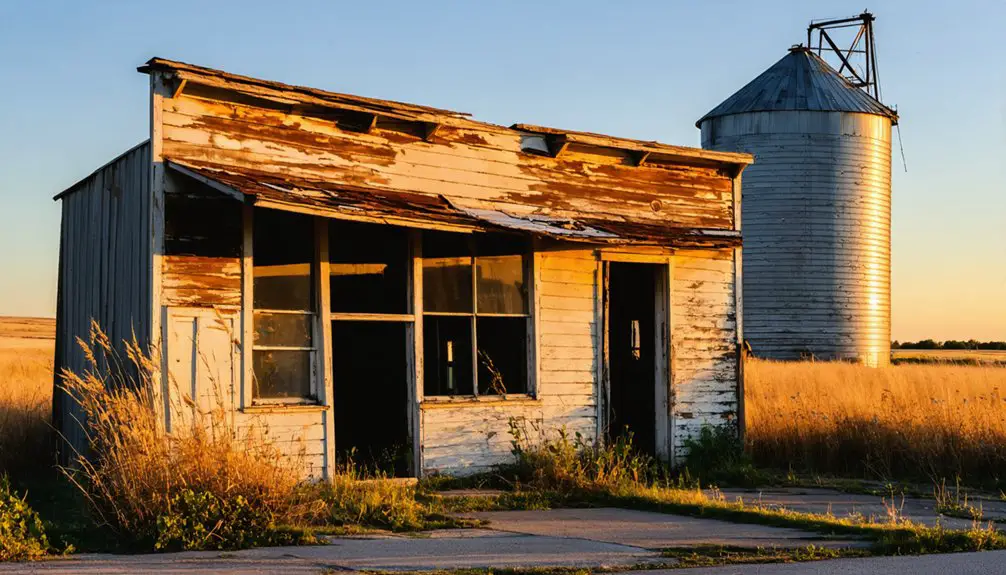You’ll find Itasca’s ghost town story began in late 1885 when the Sherman County Land Association established this promising frontier settlement. Though it quickly developed with businesses and a hotel, the town’s fate changed when the Chicago, Kansas and Nebraska Railroad bypassed it for Goodland in 1886. Within three years, Itasca’s residents and buildings relocated to railroad-connected towns, leaving nothing but prairie. The complete disappearance of this once-hopeful community reveals deeper tensions in Kansas’s settlement era.
Key Takeaways
- Itasca was established in 1885 in Sherman County, Kansas, but quickly declined when the railroad bypassed it in favor of Goodland.
- Local businesses and buildings, including the Commercial Hotel, were physically relocated from Itasca to Goodland for economic survival.
- The town’s demise accelerated after losing the county seat battle to Goodland in 1888, leading to mass exodus of residents.
- By late 1886, most business owners dismantled their operations and relocated along rail lines, effectively ending Itasca’s commercial viability.
- Today, nothing remains of Itasca’s original site, with the former town location completely reclaimed by Kansas prairie grassland.
The Birth of a Prairie Town
In late 1885, a new prairie settlement called Leonard emerged on the Kansas frontier, platted by the Sherman County Land Association. Named after town platter Thomas P. Leonard, the settlement faced immediate challenges when its post office applications were repeatedly rejected due to name conflicts with other Kansas towns.
You’ll find that early ambitions for the town were high, as evidenced by rapid development in spring 1886. A real estate office, school, drugstore, and livery stable quickly sprouted up alongside the newly built Commercial Hotel. The town soon became home to The New Tecumseh, which had relocated from Gandy in March. Like many other towns in the region, Itasca attracted foreign immigrants seeking new opportunities on the prairie.
To overcome the postal service hurdle, the board of trustees changed the town’s name to Itasca in August 1886. This strategic move paid off when Governor John A. Martin officially designated Itasca as a town on September 20, 1886.
Railroad Dreams and Disappointments
You’ll find that Itasca’s promising future crumbled when the Chicago, Kansas and Nebraska Railroad bypassed the town, choosing a route through nearby Goodland instead.
Local businesses quickly recognized the economic reality and began relocating their operations to Goodland to stay viable.
This pattern of towns rising or falling based on railroad routes was common during Kansas’s expansion, as railroads significantly increased land value and transformed settlement patterns across the state.
The impact of rail networks on communities remains relevant today, as shown by CPKC’s creation of the first single-line railway connecting Canada, the U.S., and Mexico.
Tracks Pass Town By
While early Kansas railroads aimed to connect major settlements, their routes were ultimately dictated by resource locations rather than existing towns. You can trace Itasca’s decline to these essential railroad decisions, as tracks bypassed the young settlement in favor of other locations.
Despite G. M. Dodge purchasing land for railroad development in 1881, the Missouri, Kansas and Texas Railroad chose alternate routes, creating economic limitations that would plague the town’s future.
While nearby Goodland thrived with its roundhouse and stockyards after the Chicago, Kansas and Nebraska Railroad arrived in 1888, Itasca struggled without direct rail access.
You’ll find that towns along the tracks, like Ruleton and Lanborn, gained population and commerce, while Itasca’s growth stalled. Without the critical railway connection, the town couldn’t compete with the robust trade and transportation advantages enjoyed by its rail-connected neighbors.
Business Migration Begins
The railroad’s decision to bypass Itasca triggered a swift exodus of local businesses by late 1886.
You’d have seen store owners dismantling their operations and relocating several miles away to position themselves along the new rail lines, recognizing that their survival depended on railway access.
The business relocation proved dramatic as Itasca’s commercial core dissolved.
The town’s Commercial Hotel and Swigart Building were physically moved to Goodland, while other enterprises scattered to Sherman Center and Eustis.
Much like the Santa Fe Railway would later demonstrate its influence on towns through record-breaking routes, railroad access shaped the destinies of early Kansas settlements.
Railroad influence dictated these moves, as merchants needed to maintain essential shipping routes and customer accessibility.
The pattern was clear – where the tracks went, commerce followed.
Without rail connections, Itasca couldn’t compete with neighboring towns that offered the transportation access businesses required to thrive.
Like many Kansas towns without railroads, Itasca faced the same struggles as communities that lost their last passenger trains decades later.
Empty Buildings Move Away
As railroad dreams faded in 1887, Itasca’s remaining buildings faced a stark choice – move or decay.
You’d have witnessed an extraordinary sight as entire structures were methodically dismantled and loaded onto flatcars, following the railway’s new path toward more promising destinations.
Building relocation became the preferred solution rather than letting these abandoned structures waste away. Hotels, diners, and shops that once bustled with railway passengers were carefully taken apart, board by board. Much like the historic Sheridan automobile brand, these buildings represented an era of American innovation and development that was quickly fading away.
Like many Kansas ghost towns before it, Itasca saw its physical infrastructure migrate to new railroad termini where economic opportunities still flourished.
The meticulous process of moving buildings preserved valuable materials and investments, giving these structures new life in growing communities while leaving behind little more than empty lots and fading memories.
Life in Early Itasca
You’ll find that daily life in early Itasca mirrored the typical frontier experience, with settlers operating general stores, hotels, and saloons to serve the growing community.
Similar to bustling lumber towns, these commercial establishments provided essential services to meet the needs of the local population.
While specific records remain limited, the town’s businesses created natural gathering spots where residents could socialize and conduct commerce during Itasca’s brief period of prosperity.
Like Fred Harvey’s success with his railroad restaurants, these commercial establishments helped sustain the town’s early development.
These commercial and social activities centered around key structures like the Commercial Hotel and Swigart Building, though these would eventually be relocated to Goodland as the town’s fortunes declined.
Daily Pioneer Activities
During Itasca’s pioneer days, daily life centered around a bustling mix of logging operations and essential services that supported the growing community.
You’d find workers heading to lumber camps near lakes, while others operated hotels, general stores, and repair shops. Family routines revolved around the town’s steady growth and logging activities.
Daily life in Itasca offered a blend of work and frontier freedom:
- You could visit the local saloon after a hard day’s work, or take your tools to the blacksmith for repairs.
- Your children would play freely in the streets and on swings while you tended to business.
- You’d rely on the town’s newspaper to stay informed, or visit the doctor when medical care was needed.
The railroad’s arrival transformed these routines, connecting Itasca’s pioneers to wider opportunities and markets.
Business and Social Life
While lumber companies initially drove Itasca’s development, the town quickly evolved into a diverse business hub serving both permanent residents and transient workers.
You’d find essential services like general stores, barber shops, shoemakers, and a doctor’s office alongside numerous saloons that catered to the logging workforce.
Social interactions centered around these establishments, with general stores and barber shops serving as popular spots for community gatherings. The local newspaper kept everyone connected, while hotels housed visiting businessmen and workers.
However, when the railroad bypassed Itasca in 1886, you’d witness a rapid decline as businesses relocated to nearby railroad towns like Sherman Center and Eustis.
Within a year, many buildings, including the Commercial Hotel and Swigart Building, were moved to Goodland, leaving Itasca virtually abandoned.
The Battle for County Seat Status

As tensions mounted in Sherman County during 1886, a fierce battle erupted between several ambitious towns competing for the coveted county seat status. Itasca joined Voltaire, Sherman Center, and Eustis in a contentious struggle that would shape the region’s future.
When Eustis won temporary status through a disputed election, the conflict intensified.
- Legal injunctions prevented vote counting while accusations of unfairness spread
- Court battles and commission meetings dragged on through late 1887
- The Kansas National Guard arrived in January 1888 to maintain order
The dispute finally ended when Goodland emerged as a compromise location, winning with 872 votes.
After years of bitter rivalry, Goodland’s selection as county seat brought peace to Sherman County’s divided communities.
While other Kansas county seat battles often turned violent, Sherman County’s conflict was resolved without bloodshed, though Itasca’s dreams of becoming the county’s governmental center were permanently dashed.
Exodus to Neighboring Towns
Once Itasca lost its bid for county seat status in 1888, residents began a steady exodus to neighboring towns that offered better economic prospects and governmental services.
You’d have witnessed a dramatic community migration as the post office, businesses, and civic institutions relocated, leaving Itasca increasingly isolated.
The town’s economic decline accelerated as neighboring communities, better positioned along railroads and highways, attracted former residents with stable jobs and improved infrastructure.
You’d have seen families following their churches and schools to these growing towns, where they found stronger social connections and commercial opportunities.
The pattern became self-reinforcing – as more people left, fewer reasons remained to stay.
This dispersal of Itasca’s population reflected a broader trend of rural consolidation occurring throughout Kansas during this period.
Legacy of Lost Buildings

Though abandoned decades ago, Itasca’s remaining buildings tell a compelling story of rural Kansas life through their deteriorating frames and weathered walls.
You’ll find former service stations, stores, and schoolhouses slowly succumbing to time’s relentless march. These abandoned structures, while dangerous to explore, hold tremendous historical significance as they reveal the architectural styles and community planning of early Kansas settlements.
The legacy of these buildings serves as a powerful reminder:
- They represent an era when small farming communities thrived across Kansas
- Their decay mirrors the broader story of rural depopulation in America
- They stand as silent witnesses to the dreams and daily lives of past residents
Despite their deterioration, these weathered remnants continue to shape our understanding of Kansas’s rural heritage.
Sherman County’s Ghost Town Heritage
When Sherman County officially organized in 1886, its landscape was dotted with ambitious frontier settlements like Eustis, Voltaire, Gandy, and Itasca.
You’ll find that each of these ghost towns carried unique historical significance, from Inez’s pre-1880 establishment to Gandy’s brief reign as county seat.
The area’s rich heritage includes Native American tribes like the Kiowa and Cheyenne, followed by diverse European settlers from Sweden, Germany, and Austria.
Ghost town preservation efforts have been challenged by private land ownership and the complete disappearance of many original structures.
Yet you can still trace Sherman County’s development through its vanished towns, from the county seat battles that absorbed Eustis into Goodland to Voltaire’s decline after the devastating 1886 blizzard.
Local folklore and paranormal tales help keep these lost settlements’ memories alive.
Vanished Without a Trace: Modern Day Site

Unlike other ghost towns in Sherman County that left behind ruins or landmarks, the original site of Itasca has completely vanished from the modern landscape.
Today, if you visit the area, you’ll find nothing but open prairie where this once-promising town stood in the 1880s. Historical research confirms the town’s existence through documentation, but its physical presence has been erased by time.
The modern significance of Itasca’s disappearance serves as a stark reminder of how quickly frontier settlements could fade:
- No buildings or structures survived the mass exodus after losing the county seat bid
- Natural prairie growth has reclaimed the entire town site without preservation
- Land records are the only remaining proof of Itasca’s exact location
The area now blends seamlessly with surrounding farmland, leaving visitors to imagine what once existed there.
Frequently Asked Questions
What Was the Peak Population of Itasca During Its Brief Existence?
You’ll find in Itasca’s history that over 600 people called it home during its peak, though population decline quickly followed as mining operations ceased in the early 1900s.
Were There Any Schools or Churches Established in Itasca?
You won’t find any school history or church significance here – there’s no evidence of either being established during the town’s brief existence before it was abandoned by 1888.
What Native American Tribes Originally Inhabited the Itasca Area?
The Kanza (Kaw) and Osage tribes were your area’s primary Native tribes, establishing cultural heritage through villages and settlements. Later, Comanche and Wichita peoples also influenced this Kansas territory.
Did Any Famous Historical Figures Ever Visit or Stay in Itasca?
You won’t find any verified records of famous visitors or historical significance in Itasca’s brief existence – the town declined too quickly during the 1880s to attract notable personalities.
What Was the Average Property Value in Itasca Before Abandonment?
While property records are worth their weight in gold, you’d find average properties selling between $20,000-$85,000 before abandonment, with historical significance boosting some values towards the higher end.
References
- https://lptv.org/itasca-state-park-explores-histories-of-ghost-towns-with-summer-tour-series/
- https://fhsuguides.fhsu.edu/kansasheritage/shermancounty
- https://www.the-driveby-tourist.com/kansas-ghost-towns/
- https://digging-history.com/2014/09/17/ghost-town-wednesday-ghost-towns-of-sherman-county-kansas/
- https://www.youtube.com/watch?v=OyBXD18P_j4
- https://en.wikipedia.org/wiki/Sheridan
- https://fhsuguides.fhsu.edu/kansasheritage/sheridancounty
- http://kansasheritage.org/research/rr/rrhistory.html
- https://en.wikipedia.org/wiki/Canadian_Pacific_Kansas_City
- https://www.tshaonline.org/handbook/entries/itasca-tx



